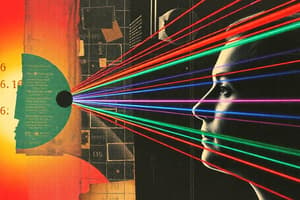Podcast
Questions and Answers
In the context of multi-photon processes, atomic ______ (e.g., off-diagonal elements of the atomic reduced density matrix) are not important in incoherent interactions.
In the context of multi-photon processes, atomic ______ (e.g., off-diagonal elements of the atomic reduced density matrix) are not important in incoherent interactions.
coherences
A typical example of a coherent interaction is a ______ transition, where two photons can stimulate a dipole-forbidden transition via an excited state.
A typical example of a coherent interaction is a ______ transition, where two photons can stimulate a dipole-forbidden transition via an excited state.
Raman
In ______ interactions, no energy is exchanged between the light and the atoms, but the atoms mediate interactions between multiple light beams, like four-wave mixing.
In ______ interactions, no energy is exchanged between the light and the atoms, but the atoms mediate interactions between multiple light beams, like four-wave mixing.
parametric
In a three-level Lambda system, a single ______ state mediates transitions between two lower-energy states.
In a three-level Lambda system, a single ______ state mediates transitions between two lower-energy states.
In the Lambda system, transitions from the metastable state $|2\rangle$ to $|1\rangle$ are dipole ______, leading to a long lifetime for the metastable state.
In the Lambda system, transitions from the metastable state $|2\rangle$ to $|1\rangle$ are dipole ______, leading to a long lifetime for the metastable state.
The two-photon detuning $\delta$ is defined as $\delta = \Delta_1 - \Delta_2$, where $\Delta_1$ and $\Delta_2$ are the single-photon ______.
The two-photon detuning $\delta$ is defined as $\delta = \Delta_1 - \Delta_2$, where $\Delta_1$ and $\Delta_2$ are the single-photon ______.
If single photon detunings $\Delta_1$ and $\Delta_2$ are large and similar, such that $\Delta \gg \Omega_1, \Omega_2, \gamma_{31}, \delta$, the excited state amplitude can be considered nearly ______.
If single photon detunings $\Delta_1$ and $\Delta_2$ are large and similar, such that $\Delta \gg \Omega_1, \Omega_2, \gamma_{31}, \delta$, the excited state amplitude can be considered nearly ______.
By absorbing a photon on transition $v_1$ and emitting a photon of frequency $v_2$, population can be ______ transferred between the two ground states.
By absorbing a photon on transition $v_1$ and emitting a photon of frequency $v_2$, population can be ______ transferred between the two ground states.
The total decay rate out of level $|3\rangle$ is given by $\gamma_3 = \gamma + \tilde{\gamma}$, where $\gamma$ is the decay rate from $|3\rangle$ to $|1\rangle$ and $\tilde{\gamma}$ is the decay rate from $|3\rangle$ to ______.
The total decay rate out of level $|3\rangle$ is given by $\gamma_3 = \gamma + \tilde{\gamma}$, where $\gamma$ is the decay rate from $|3\rangle$ to $|1\rangle$ and $\tilde{\gamma}$ is the decay rate from $|3\rangle$ to ______.
In the stochastic wavefunction method, a ______ Hamiltonian is used to incorporate decay channels into the system.
In the stochastic wavefunction method, a ______ Hamiltonian is used to incorporate decay channels into the system.
The non-Hermitian Schrodinger equation yields equations of motion for stochastic wavefunction amplitudes, where $\dot{c}_1 = ______$
The non-Hermitian Schrodinger equation yields equations of motion for stochastic wavefunction amplitudes, where $\dot{c}_1 = ______$
Regardless of the mathematical manipulations employed, it is important to always check at the end that the probability for ______ jumps is indeed small.
Regardless of the mathematical manipulations employed, it is important to always check at the end that the probability for ______ jumps is indeed small.
For a weak probe field $\Omega_1$ and a constant field $\Omega_2$ of arbitrary strength, to zeroth order in $\Omega_1$ a system which starts in $|1\rangle$ will remain in $|1\rangle$, so $c_1(t) \approx ______$.
For a weak probe field $\Omega_1$ and a constant field $\Omega_2$ of arbitrary strength, to zeroth order in $\Omega_1$ a system which starts in $|1\rangle$ will remain in $|1\rangle$, so $c_1(t) \approx ______$.
When using adiabatic elimination, for far-detuned systems with $\Delta >> \Omega_{1,2}$, one can approach the system of equations by setting $\rho_{32} = \rho_{31} = ______$.
When using adiabatic elimination, for far-detuned systems with $\Delta >> \Omega_{1,2}$, one can approach the system of equations by setting $\rho_{32} = \rho_{31} = ______$.
In the density matrix approach, the equation of motion is $\dot{\rho} = \mathcal{L}{31}(\rho) + \mathcal{L}{32}(\rho) + i[\hat{H}, \rho]$, where $\mathcal{L}{31}$ and $\mathcal{L}{32}$ are the ______ operators.
In the density matrix approach, the equation of motion is $\dot{\rho} = \mathcal{L}{31}(\rho) + \mathcal{L}{32}(\rho) + i[\hat{H}, \rho]$, where $\mathcal{L}{31}$ and $\mathcal{L}{32}$ are the ______ operators.
In the A system, by using the ______ equation for the Hamiltonian yielding equations of motion for the population amplitudes.
In the A system, by using the ______ equation for the Hamiltonian yielding equations of motion for the population amplitudes.
In the limit of radiative decoherence, $\gamma_{ij}$ will be equal to ______ the sum of the decay rates out of $|i\rangle$ and $|j\rangle$.
In the limit of radiative decoherence, $\gamma_{ij}$ will be equal to ______ the sum of the decay rates out of $|i\rangle$ and $|j\rangle$.
For the density matrix components in the non-Hermitian Schrodinger equation, $p_{11} = |c_1|^2 = ______$.
For the density matrix components in the non-Hermitian Schrodinger equation, $p_{11} = |c_1|^2 = ______$.
The system behaves as though the two levels |1> and |2> are coupled by a field with effective ______ frequency.
The system behaves as though the two levels |1> and |2> are coupled by a field with effective ______ frequency.
In the stochastic wavefunction method, we are free to use the Schrodinger Equation $i\hbar |\dot{\psi}\rangle = H_{eff}|\psi\rangle$ so long as the probability for a ______ jump is small.
In the stochastic wavefunction method, we are free to use the Schrodinger Equation $i\hbar |\dot{\psi}\rangle = H_{eff}|\psi\rangle$ so long as the probability for a ______ jump is small.
Flashcards
Incoherent interactions
Incoherent interactions
Atomic coherences are not important. One applied field modifies atomic populations while another probes them.
Coherent interactions
Coherent interactions
Atomic coherences are important, and two or more photons are required to generate them. Two photons stimulate a dipole-forbidden transition via an excited state.
Parametric interactions
Parametric interactions
No energy is exchanged between the light and the atoms, but the atoms mediate interactions between multiple light beams.
Λ level configuration
Λ level configuration
Signup and view all the flashcards
Radiative decay
Radiative decay
Signup and view all the flashcards
Dipole forbidden
Dipole forbidden
Signup and view all the flashcards
Study Notes
Multi-Level Systems and Multi-Photon Processes
- Shifts from two-level atom interactions to multi-level systems interacting with multiple optical fields
- Multi-photon processes are categorized into incoherent, coherent, and parametric interactions
Classes of Multi-Photon Processes
- Incoherent interactions lack importance of atomic coherences; saturation spectroscopy is an example
- One applied field modifies atomic populations while another probes them
- Coherent interactions rely on atomic coherences and require multiple photons; Raman transitions exemplify this
- Two photons stimulate a dipole-forbidden transition using an excited state
- Parametric interactions involve no energy exchange between light and atoms
- Atoms mediate interactions between multiple light beams (e.g., four-wave mixing)
Chapter 5 Focus
- Concentrates on multi-photon processes involving atomic coherences and populations.
- Multi-photon interactions drive dipole-forbidden transitions with long-lived atomic coherence using two or more fields
Raman Transitions in Λ Level Configuration
- Focus on a three-level Λ system where a single excited state mediates transitions between two lower-energy states
- Transitions to the excited state are dipole allowed, causing rapid radiative decay
- Transitions between the two lower-energy states are dipole forbidden, thus creating a metastable state with a long lifetime.
- Radiative decay paths are faster than the metastable state decay rate, thus accounting for both avoids divergences
Schrodinger Equation Approach
- Identifies single-photon detunings (∆1, ∆2) and two-photon detuning (δ = ∆1 - ∆2) to formulate the Hamiltonian in a rotating frame:
- Ĥ = −∆1|3〉〈3| − δ|2〉〈2| − (Ω1|3〉〈1| + Ω2|3〉〈2| + Ω∗1|1〉〈3| + Ω∗2|2〉〈3|)
- Energy of |1〉 is assumed to be zero, and decay terms are temporarily neglected
- General state is expressed as |ψ〉 = c1(t)|1〉 + c2(t)|2〉 + c3(t)|3〉.
Λ System Dynamics
- Schrodinger equation for the Hamiltonian leads to equations of motion for population amplitudes:
- ċ1 = iΩ∗1c3
- ċ2 = iδc2 + iΩ∗2c3
- ċ3 = i∆1c3 + iΩ1c1 + iΩ2c2
- The Λ system has an easy solution when single photon detunings are similar but very large: ∆1 ≈ ∆2 = ∆ >> Ω1, Ω2, γ3, δ
- Excited state amplitude is constant to the lowest order in Ω1,2/∆: c3 = −(Ω1c1 + Ω2c2) / ∆
- Substituting back into motion equations yields evolution equations for probability amplitudes of the lower states
Effective Rabi Frequency
- System behaves like levels |1〉 and |2〉 coupled by a field
- Effective Rabi frequency: Ωeff = −(Ω∗2Ω1) / ∆
- Population is coherently transferred between ground states through photon absorption (ν1) and emission (ν2)
- Results in significant coherence (ρ21 = c2c∗1)
- Excited state population is suppressed due to large detuning (∆), leading to small spontaneous emission probability
Density Matrix Equation of Motion
- ρ̇ = L31(ρ) + L32(ρ) + i[Ĥ, ρ]
- Louvillian operators (L31, L32) account for decays from |3〉 to |2〉 and |3〉 to |1〉
- For example: L31 = − γ3→1/2 (σ31σ13ρ − σ13ρσ31 + h.c.)
- Louvillian operators account for decay from |3〉 to |1〉 at rate γ, from |3〉 to |2〉 at rate γ̃, and from |2〉 to |1〉 at rate γ’
- Total decay rate from |3〉 is γ3 = γ + γ̃, and from |2〉 is γ2 = γ’
- Equations of motion for the Lambda system:
- ρ̇11 = −iΩ1ρ13 + iΩ∗1ρ31 + γρ33 + γ’ρ22
- ρ̇22 = −iΩ2ρ23 + iΩ∗2ρ32 − γ’ρ22 + γ̃ρ33
Coherence and Decay
- Equations for coherence:
- ρ̇21 = −(γ12 − iδ)ρ21 + iΩ∗2ρ31 − iΩ1ρ23
- ρ̇31 = −(γ13 − i∆)ρ31 + iΩ2ρ21 + iΩ1(ρ11 − ρ33)
- ρ̇32 = −(γ23 − i(∆ − δ))ρ32 + iΩ2(ρ22 − ρ33) + iΩ1ρ12
- Remaining equations use ρji = ρ∗ij and ρ11 + ρ22 + ρ33 = 1
- Shorthand using complex decay parameter:
- Γ12 = γ12 − iδ
- Γ13 = γ13 − i∆
- Γ23 = γ23 − i(∆ − δ)
Approximations and Limitations
- For far-detuned systems (∆ >> Ω1,2), adiabatic elimination sets ρ32 = ρ31 = 0
- Density matrix equations are complex
Stochastic Wavefunction Method
- This method incorporates decays without adding extra degrees of freedom
- Uses a non-Hermitian Hamiltonian with two decay channels: Ĥeff = Ĥ − i
γ3/2 |3〉〈3| − iγ2/2 |2〉〈2| - Schrodinger equation (i~|ψ̇〉 = Ĥeff|ψ〉) is valid when the probability for a quantum jump is small
- Pjump = ∫dt (γ2|c2(t)|2 + γ3|c3(t)|2) << 1
- Two scenarios where this constraint is met:
- Starting in |1〉 with a weak probe field (Ω1 → 0), thus causing negligible quantum jumps
- Finite population in |1〉 and |2〉 combined with slow decay from |2〉 (γ2 → 0) and with a small excited state population (ρ33 → 0), thus making quantum jumps negligible
Amplitudes and Transforms
- Non-Hermitian Schrodinger equation produces equations of motion for the stochastic wavefunction amplitudes:
- ċ1 = iΩ∗1c3
- ċ2 = −(Γ12 − iδ)c2 + iΩ∗2c3
- ċ3 = −(Γ13 − i∆1)c3 + iΩ1c1 + iΩ2c2
- Solved differently based on the regime
- Weak Ω1 with continuous wave Ω2 allows for Fourier transforms to find probability amplitudes
- (Γ12 − i(δ − ω))c2 = iΩ∗2c3
- (Γ13 − i(∆1 − ω))c3 = iΩ1 + iΩ2c2
- Fourier frequency ω replaces detuning resulting in complex decay rates Γ12 and Γ13
Density Matrix Components
- Density matrix components:
- ρ11 = |c1|2 = 1
- ρ21 = c∗1c2 = (Ω1Ω∗2) / (Γ12Γ13 + |Ω2|2)
- ρ31 = c∗1c3 = iΩ1Γ12 / (Γ12Γ13 + |Ω2|2)
- Higher-order elements such as |Ω1|2 can be disregarded
- Results can be derived directly from the master equation
Studying That Suits You
Use AI to generate personalized quizzes and flashcards to suit your learning preferences.




